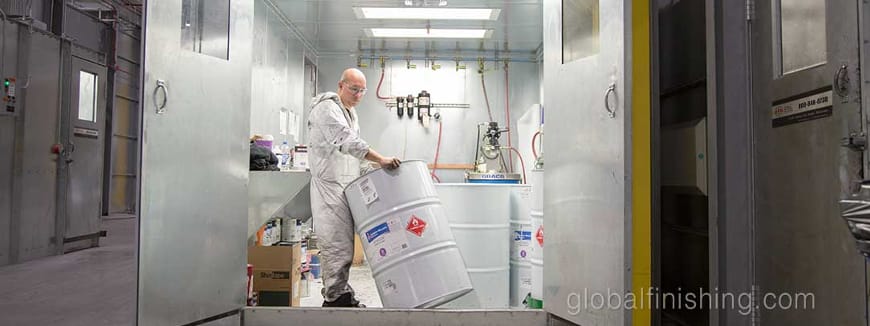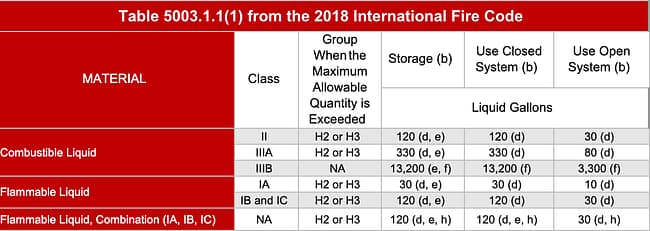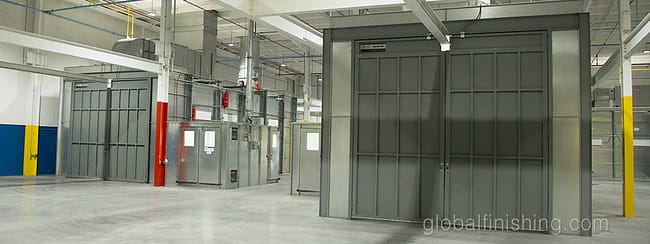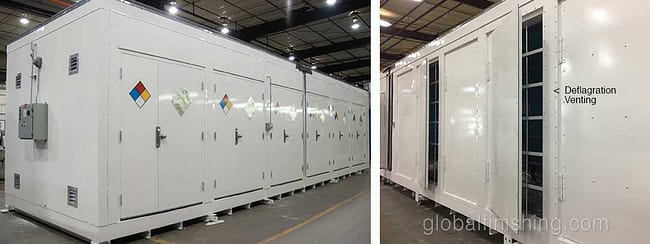
Most paints used in finishing operations are classified as either a flammable or combustible liquid. Under certain conditions, these liquids can produce vapors that may ignite, causing a fire or deflagration.
That is why codes and standards outlining proper storage guidelines have been developed to minimize risks and protect your workers, equipment and facility. Understanding these codes and standards is key when storing, dispensing or mixing paint and selecting the right type of enclosure for your needs.
Adding a Paint Mix Room or Hazardous Material Storage Building enables you to dispense or mix paint in a clean, ventilated environment, reducing the chance of contamination in your paint job.
It is important to understand the characteristics of the paints used in your operation; Safety Data Sheets (SDS) provide key information. You also should know the answers to the following commonly asked questions before investing in an enclosure for paint storage or to contain a mixing, dispensing or pumping process:
The amount of paint you can store or have in use in your facility is dependent on which class of liquid your paint falls within and the Maximum Allowable Quantity (MAQ) — the limit on the amount of flammable or combustible liquid present before additional measures are required to mitigate the hazard. The MAQ not only varies based upon the class of the liquid, but also whether the container is open or closed. The MAQ values can be found in NFPA 30, NFPA 33 and the International Fire Code (IFC). The table below is a summary of information contained in the IFC:

If your building is equipped with an automatic sprinkler system, the MAQ for storage and use can be increased by 100 percent. The amount in storage can be increased by another 100 percent (for a total increase of 200 percent) if stored in an exhausted enclosure, such as a mix room or Hazardous Material Storage Building.
When transferring paint between containers or mixing liquids into one container, code requires you to perform these operations in a mix room or in a spray booth with the ventilation on. Since mixing paint in a spray booth dramatically slows down your finishing operation, having a dedicated space such as a mix room is ideal.
If the amount of paint stored in your facility is over the MAQ, including the increases for ventilated enclosures and fire protection systems, a Hazardous Material Storage Building is your best option. With a fire-rated ceiling and walls, a Hazardous Material Storage Building creates a separate control area — an area protected from fire — from the rest of your facility.
NFPA 33 sets limits on how much liquid can be in a mix room, depending on its proximity to a spray booth. If a mix room is located adjacent to or within 6 feet of a spray booth, the combined amount of liquid in the mix room and the spray booth cannot exceed 120 gallons or 2 gallons per square foot of the mix room (whichever is less); the maximum amount of liquid permitted in a spray booth is 60 gallons. For mix rooms located more than 6 feet from a spray booth, the amount of paint in the mix room cannot exceed 2 gallons per square foot, regardless of the class of the liquid.
There is no limit on the number of mix rooms or Hazardous Material Storage Buildings allowed in one facility. However, a mix room cannot exceed 150 square feet, and no more than 300 gallons of flammable or combustible liquids may be stored among all your mix rooms combined, as they do not qualify as control areas since they are not constructed to have a fire rating.

When vapors are present, the minimum ventilation required for a mix room is 150 cubic feet per minute (CFM). Recent changes to NFPA 33 state that ventilation is required only when you have open Class I, Class II or Class III liquids at temperatures at or above their flash points. Class IA and IB liquids have a flash point below 73 degrees Fahrenheit, meaning ventilation is still required, as interior temperatures will likely exceed the flash point.
For Hazardous Material Storage Buildings, mechanical ventilation systems are required only for locations where Class I liquids are dispensed, according to NFPA 30. However, the IFC requires ventilation where paint quantities have exceeded the MAQ. For both codes, the ventilation rate is 1 CFM per square foot of floor area but not less than 150 CFM.
The electrical area classification of a mix room used to be Class I, Division 1 throughout — the same as a paint booth. The revised standard allows you to apply the guidelines in NFPA 30 to establish potentially different area classifications. While there may be some cost advantages to this approach, any changes require a re-evaluation of the area classification and may result in modifications to the wiring or the location of electrical equipment.
The location of vapor sources is the determining factor for the electrical area classification of Hazardous Material Storage Buildings. Larger Hazardous Material Storage Buildings often have more space between vapor sources. As with mix rooms, NFPA 30 guidelines can be applied to establish the area classifications in a Hazardous Material Storage Building.

The IFC requires an explosion control method if you have exceeded the MAQ for storage or use of Class IA liquids or the MAQ for open use or dispensing of Class IB liquids. Explosion control is not required for Class IC liquids, Class II liquids or Class III liquids, nor for closed-use systems involving Class IB liquids.
When explosion control is required, deflagration (explosion) venting is the most common option. If the Hazardous Material Storage Building is indoors, it must be placed along an exterior wall, where the deflagration vent panels line up with penetrations in the building wall to allow for exterior venting.
Another option to achieve explosion control is deflagration prevention through concentration reduction. A hazard analysis must be performed to determine if any additional airflow is needed to reduce the concentration of flammable vapors present during a spill or other accidental release of the materials. Frequent maintenance and calibration of the equipment is also required to ensure the system continues to provide the necessary level of protection.
By purchasing a mix room or Hazardous Material Storage Building from a manufacturer with a vast and experienced distribution network, such as GFS, you have a helping hand in navigating code compliance. GFS distributors are well-versed in the latest versions of NFPA 30, NFPA 33 and the IFC, as well as state and municipal regulations, and are also comfortable working with building inspectors to achieve code compliance.
One of the best ways to highlight your business is through a story that you can share across your online platforms. It humanizes your business and shows that your business can make a meaningful impact. Your testimonial would be used as a project profile on the GFS Booth Blog and can be shared on your website and/or social media channels.
Complete this form and we’ll be in touch to showcase your company.

Shop a variety of GFS aftermarket products, including booth protection products and mobile accelerated curing units. And enjoy the convenience of fast and free ground shipping throughout the contiguous United States.

Located at GFS’ headquarters in Osseo, Wisconsin, the Center for Excellence is an innovative facility featuring an automotive refinish training center, as well as a separate space dedicated to technical product training.

GFS is continuously searching for talented, ambitious individuals to join our team. We aim to provide our employees with every opportunity to make an impact on the company and find their niche along the way — weather in a production, field services or an office position.